News
Exploring with the Dive Ninjas: Diving with Striped Marlin at Mexico’s Secret Sardine Run
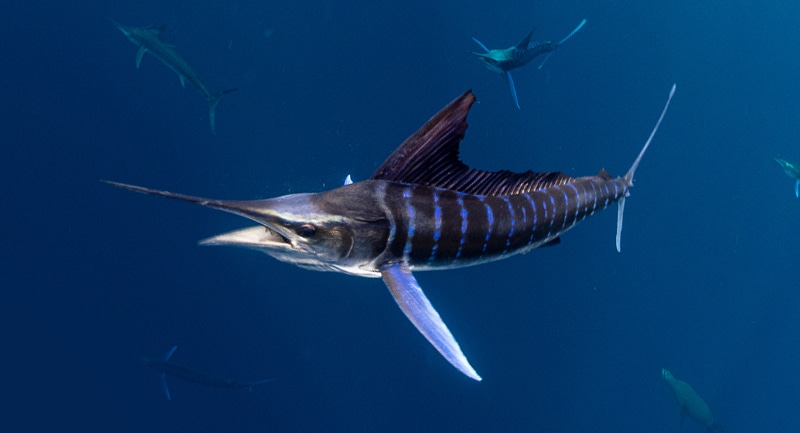
It’s November and I’m waking up in a small fishing village on Bahia Magdalena. We are about to head 20 miles offshore in search of one of my favorite open ocean encounters—and one of this region’s best kept secrets.
The warm Baja sun is just beginning to creep over the horizon as we finish loading the boat. Our captain, Mele, gives the ok to push off and we are on our way. Mele has an unmatched understanding of these magical waters. He’s a local fisherman that made the switch to working in ecotourism and conservation projects a few years ago. His passion for these waters and their inhabitants is inspiring.
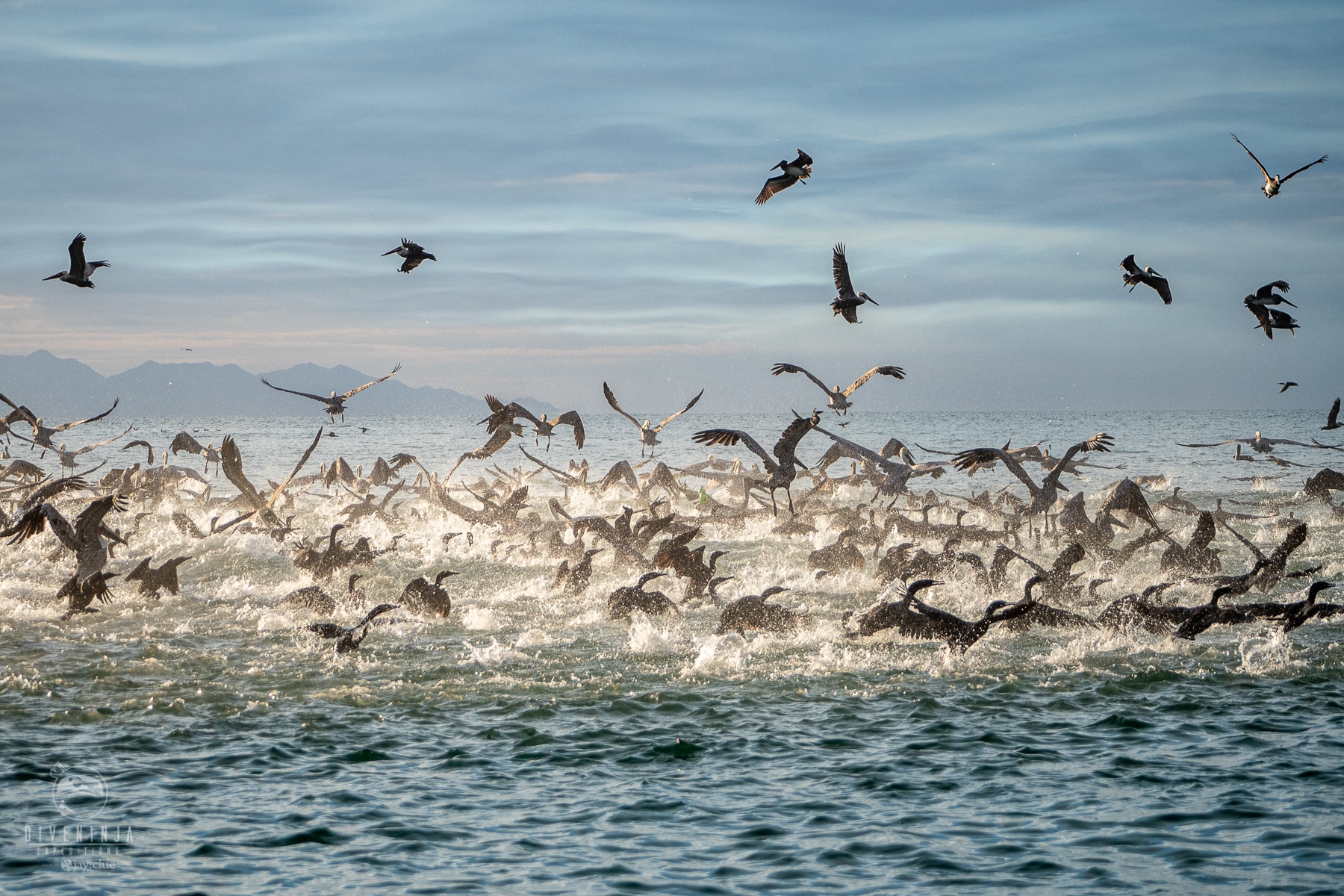
Our journey seaward takes us past Isla de Patos—a small strip of sand home to thousands upon thousands of tightly packed sea birds. Then along the mangroves that play a critical part in making this area so remarkable. As we move further offshore humpback whales are spotted breaching in the distance as they make their annual journey down the coast to Los Cabos. But the whales will have to wait because today we seek something even more extraordinary.
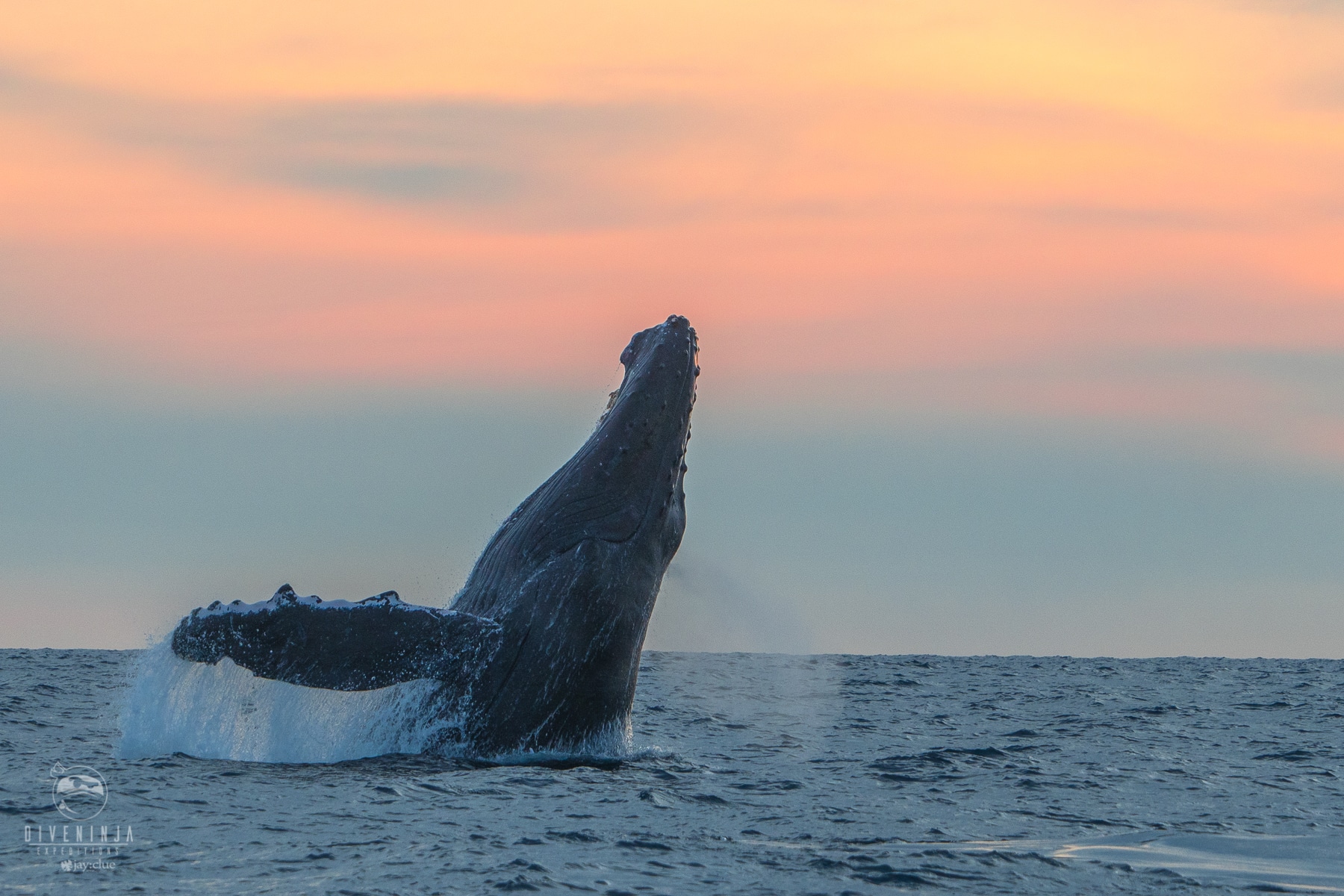
Soon we spot flocks of sea birds flickering on the horizon beckoning us to come closer – a tell-tale sign of the gigantic bait balls we seek. As we draw closer packs of sea lions can be seen lifting their heads from the water to catch quick breaths. I’m always amazed at how far offshore these salty sea dogs can be found looking for a meal. And right now, it’s breakfast time in Baja. From the boat we can already see the ripples created by a huge ball of mackerel frantically zigging and zagging just below the surface as they try to outrun one of the oceans fiercest predators.
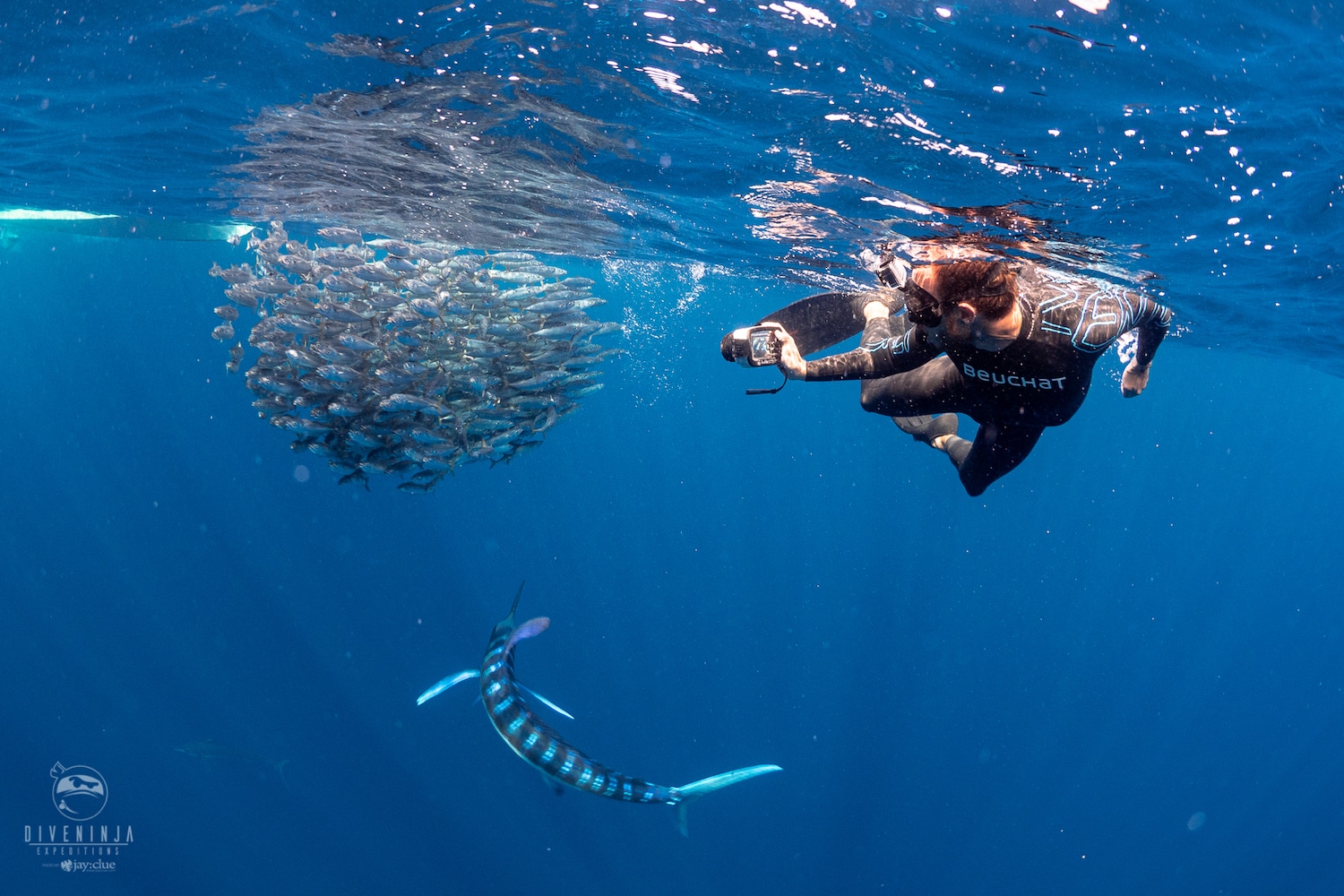
Slipping into the water gives you front row seats to one of the most action-packed experiences our oceans have to offer. Imagine over 40 Striped Marlin working together with packs of sea lions corralling their breakfast into a tight ball and pushing it up to the surface. Then one by one they rocket through the bait ball striking and spearing the fish with their sword-like bill.
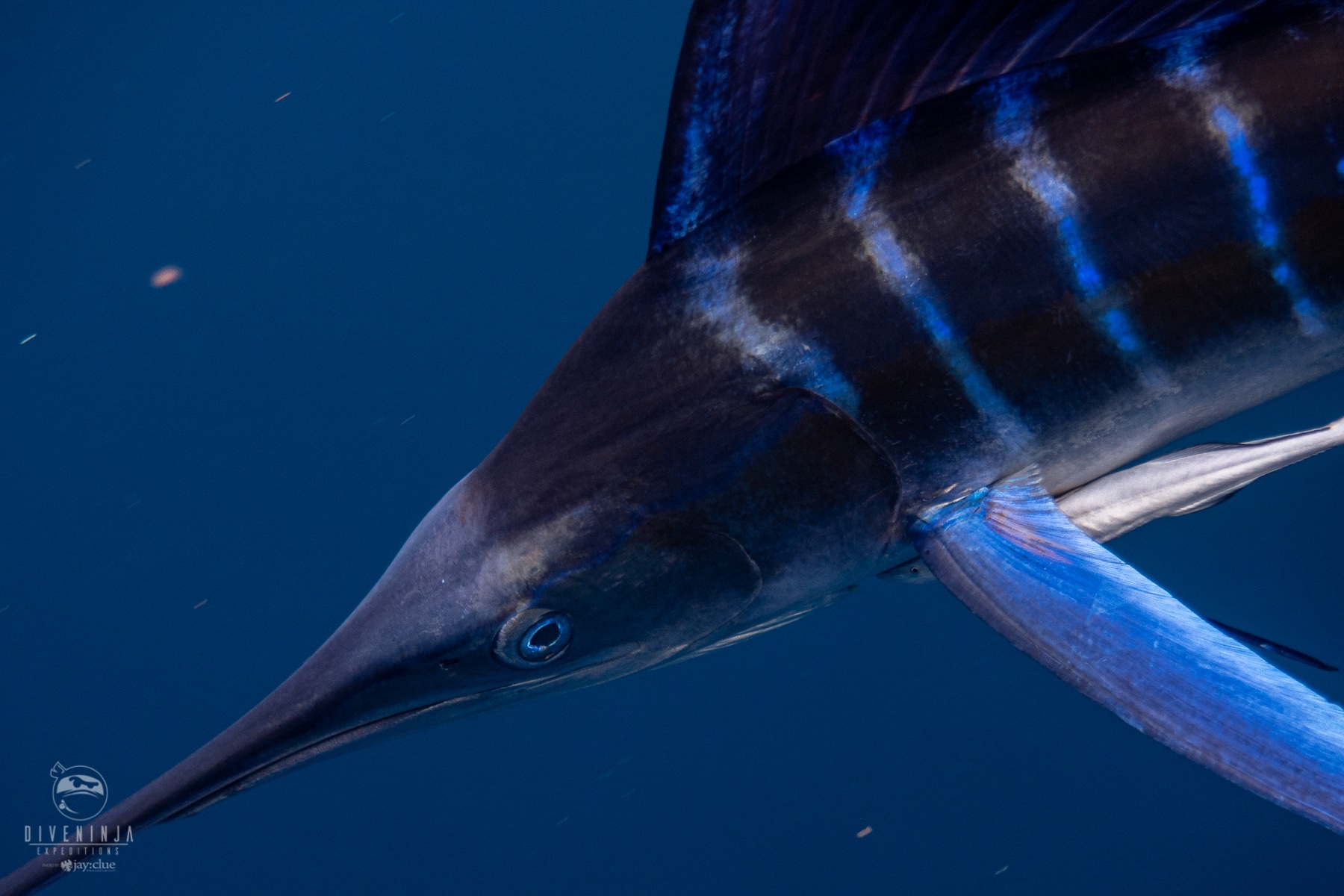
Without a moment to think they have already welcomed you into the hunt. It’s a heart pounding encounter, yet mesmerizingly beautiful. Thousands upon thousands of shimmering silver fish spiral into shapes reminiscent of liquid metal dancing on a gorgeous deep blue backdrop. All the while a barrage of sword wielding super-fish and the lions of the ocean ignite the waters around you.
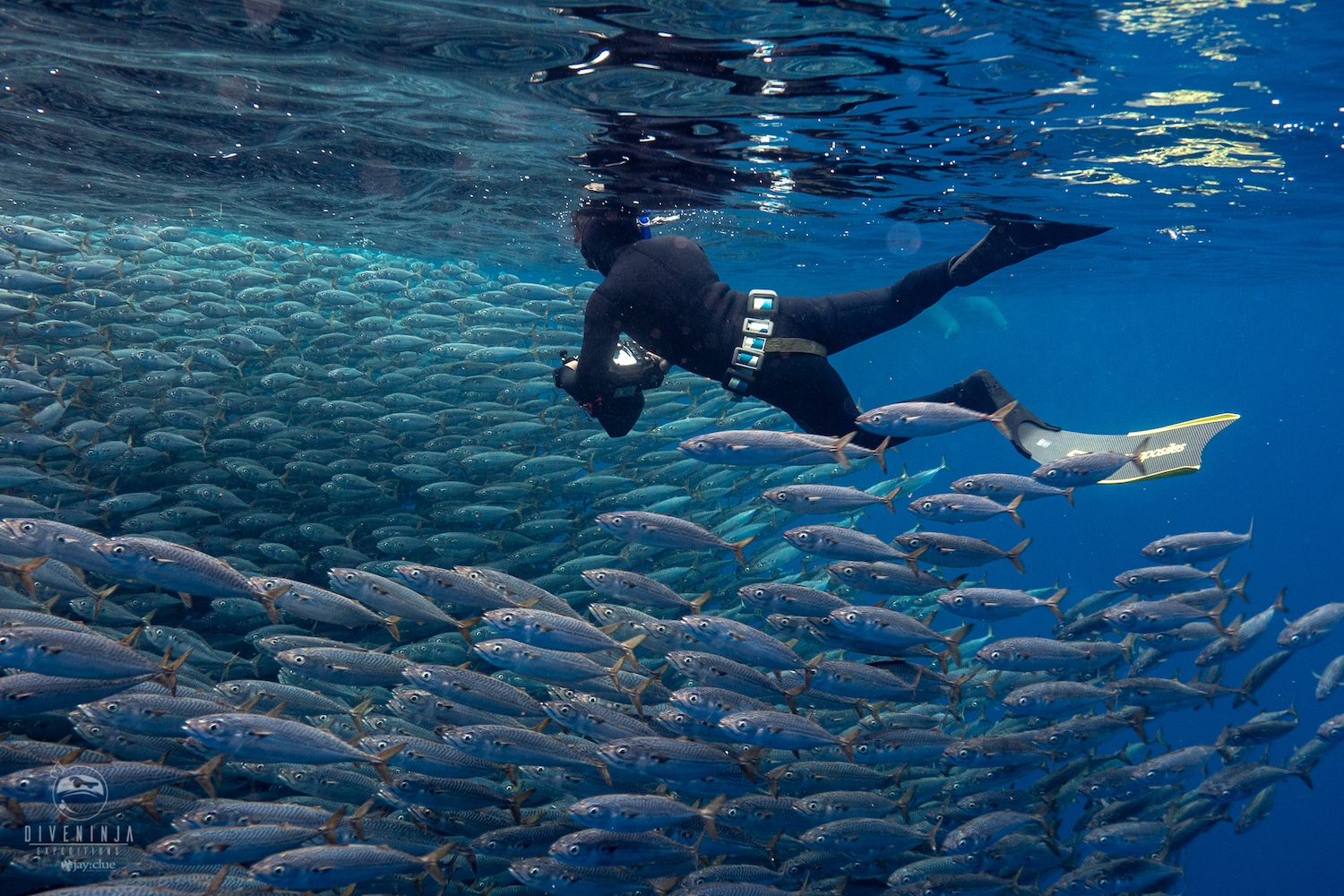
Striped Marlin, Kajikia audax, are one of our ocean’s great creations. A super-fish engineered for extreme speed and vast open ocean migrations. They are one of the fastest animals in the ocean and capable of quickly reaching speeds of 80 kmh (50 mph). Striped marlin are a highly adapted apex predator. Their bodies have insets that allow their fins to lay completely flat when tucked in to help eliminate drag.
Marlin can even heat their eyes and brain to help them be able to manage such great speed and agility. Although not the largest species in the billfish family, they can grow nearly 4 meters (12 ft) long and weigh upwards of 190 kgs (450 lbs). Their long bill is covered in millions of rough denticles and is thought to decrease hydrodynamic drag as they slice through the water—in addition to being used for hunting and protection.
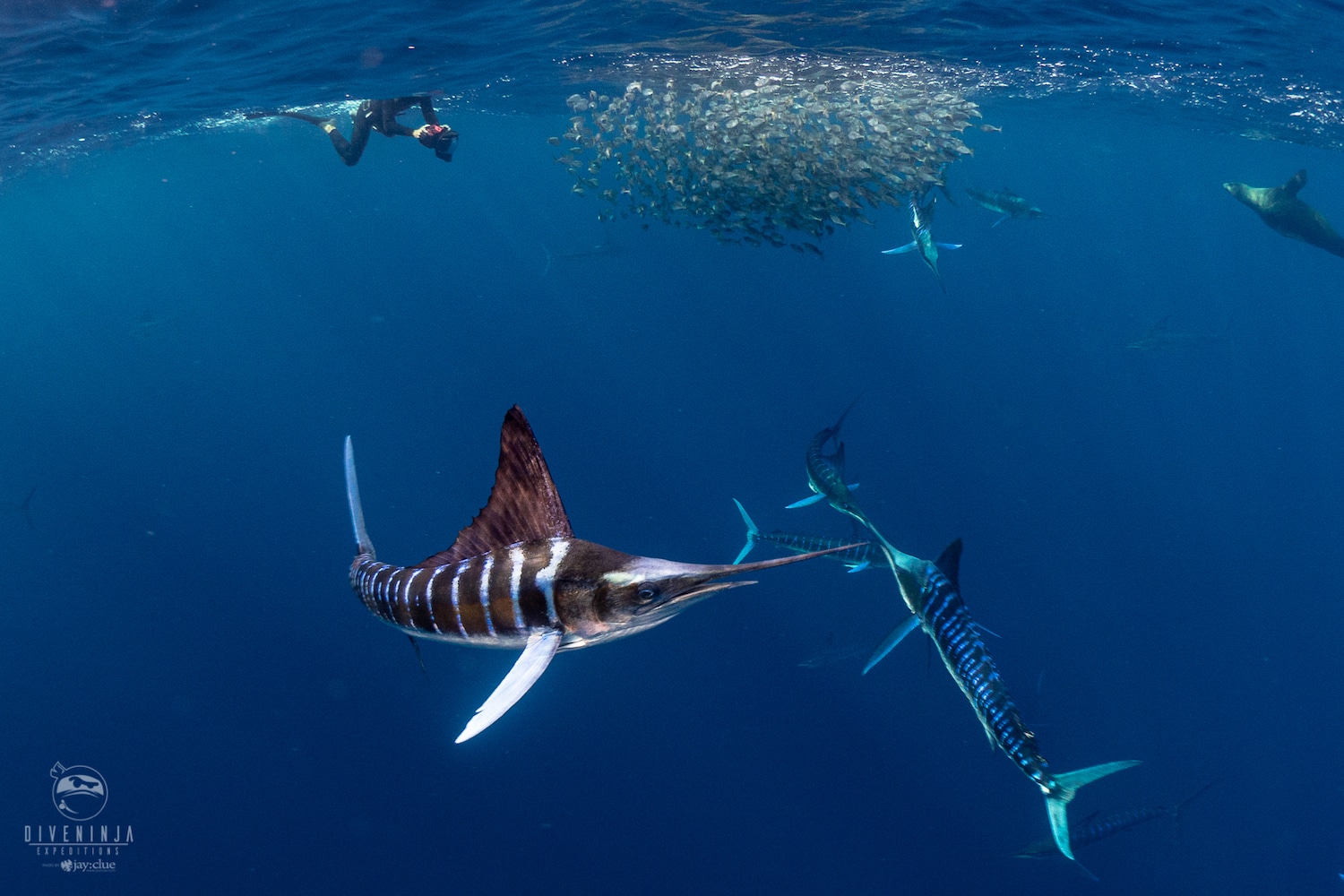
However, these beautiful creatures are listed as Near threatened on the IUCN Red List with their populations steadily decreasing. They are the prized subject of many sport fishermen and Los Cabos to the south is considered the sport fishing capital of the world. It hosts one of the largest sport fishing tournaments on earth as well as a big marina packed with sport fishing vessels running charters 365 days per year. It’s estimated that more than 12,000 striped marlin are fished each year just in the waters around Los Cabos.
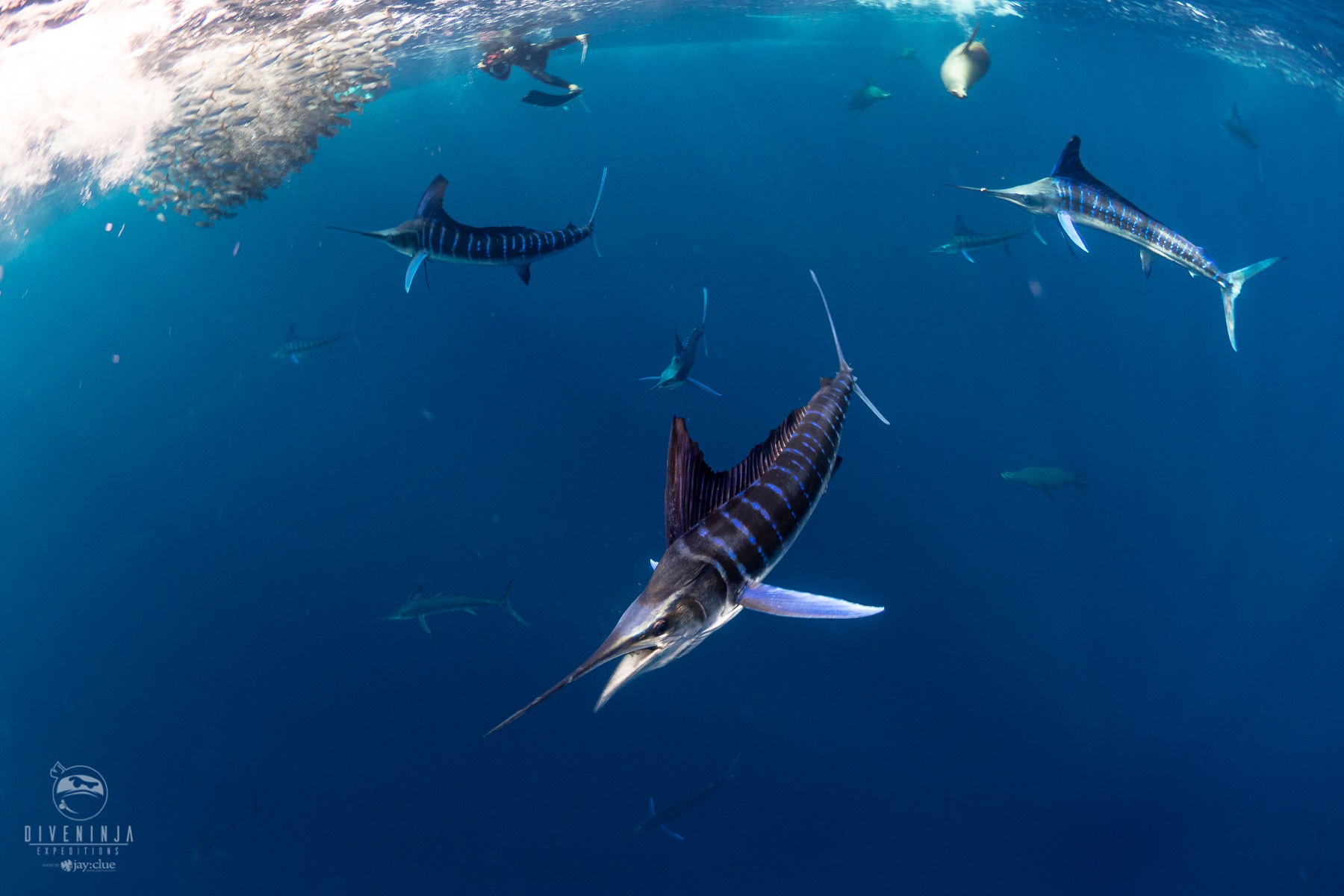
Because of this Cabo San Lucas based Dive Ninja Expeditions has teamed up with Nakawe Project to integrate a new marlin research & conservation project into their annual marlin expeditions. The new project hopes to help better understand the population in Baja as well as look at the sustainability and impacts of fishing, while taking you to experience this awesome natural event firsthand.
How to Experience it
The season for these incredible striped marlin encounters takes place every autumn along the pacific coast of Baja California Sur, Mexico. The marlin normally begin to start arriving in late September and will stay through December. This means warmer, blue waters and good visibility. You’ll still want to pack a wetsuit, as this is the eastern Pacific, but a 5mm should be good for most. Your nearest major airport will be Los Cabos International, which offers direct flights from many US & Mexican cities.
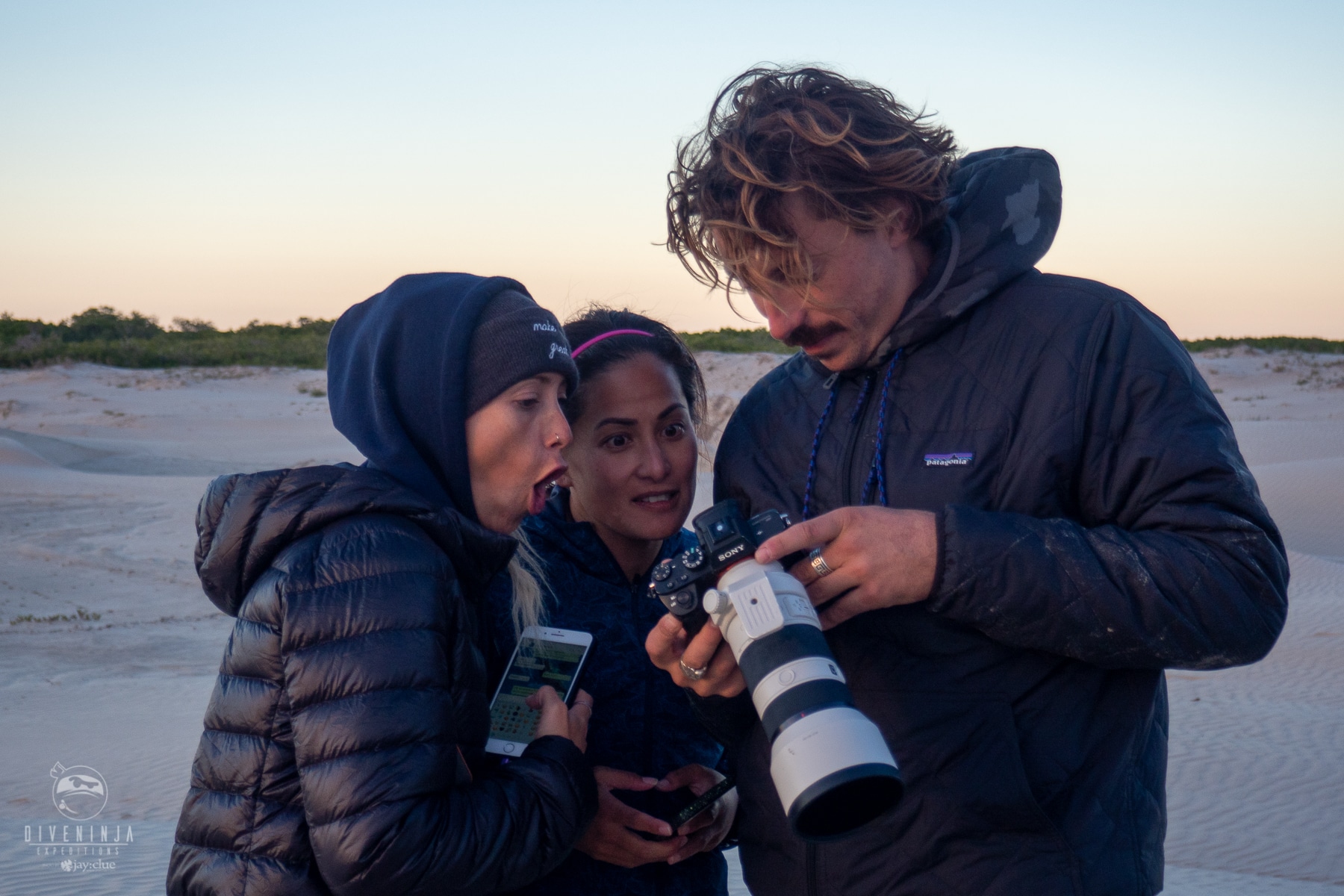
Getting to the action though can be a bit of an undertaking, especially if you aren’t familiar with the area. There are a few locations where you can get in the water with the marlin, with the nearest one being a couple hours drive from Los Cabos. These are small fishing towns though, most without any proper tourism facilities. However, there are a couple operators that run multi-day trips out to experience the marlin and bait balls.
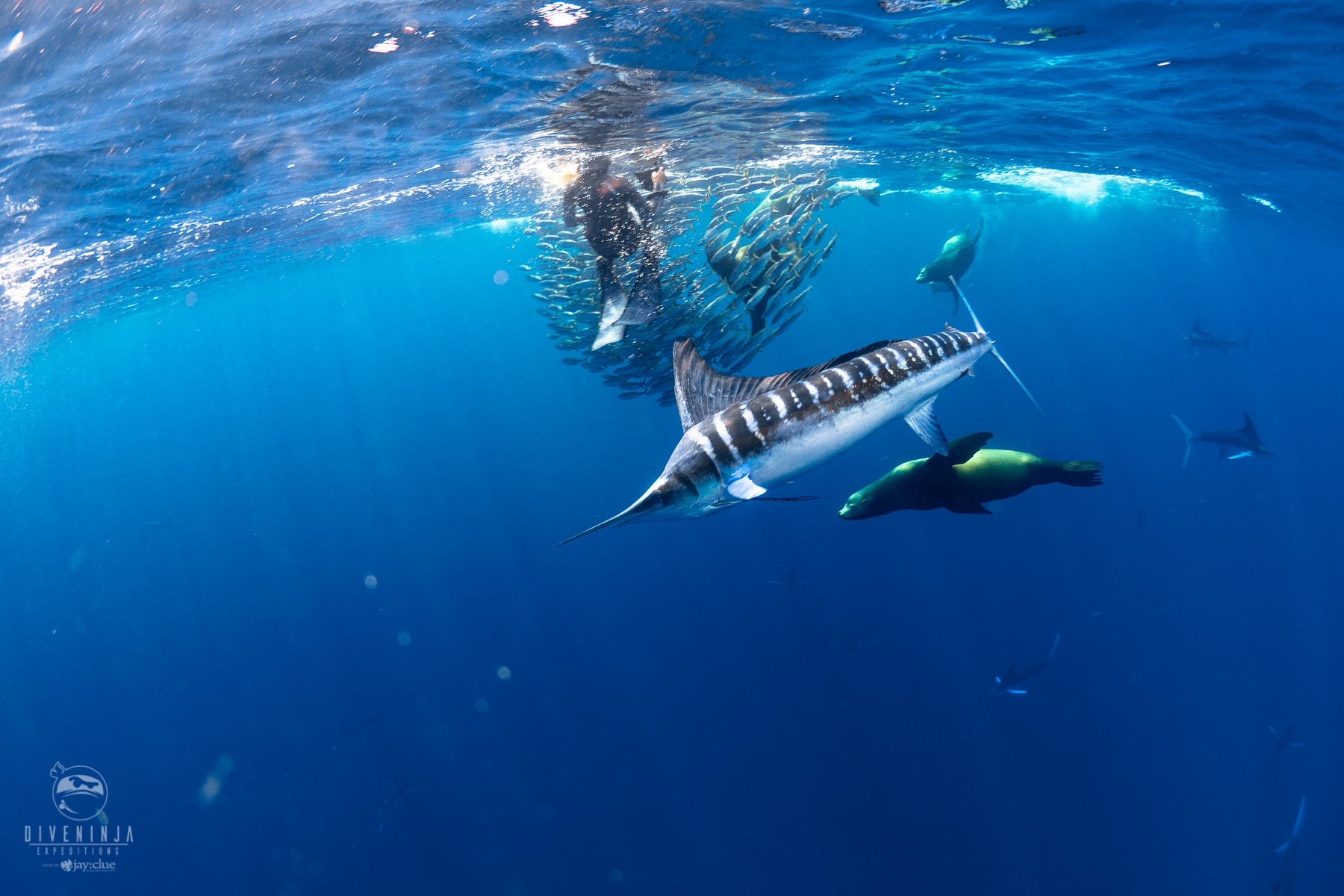
Dive Ninja Expeditions is one of the few operators that regularly run weekly trips each season. They have been actively working on projects in these areas for a few years that help support the local communities and further ongoing research and conservation efforts. They also work in these areas all year long on different specialized expeditions, so they know the local areas better than most. Whereas all of the other ops usually just pop in for a week or two each year.
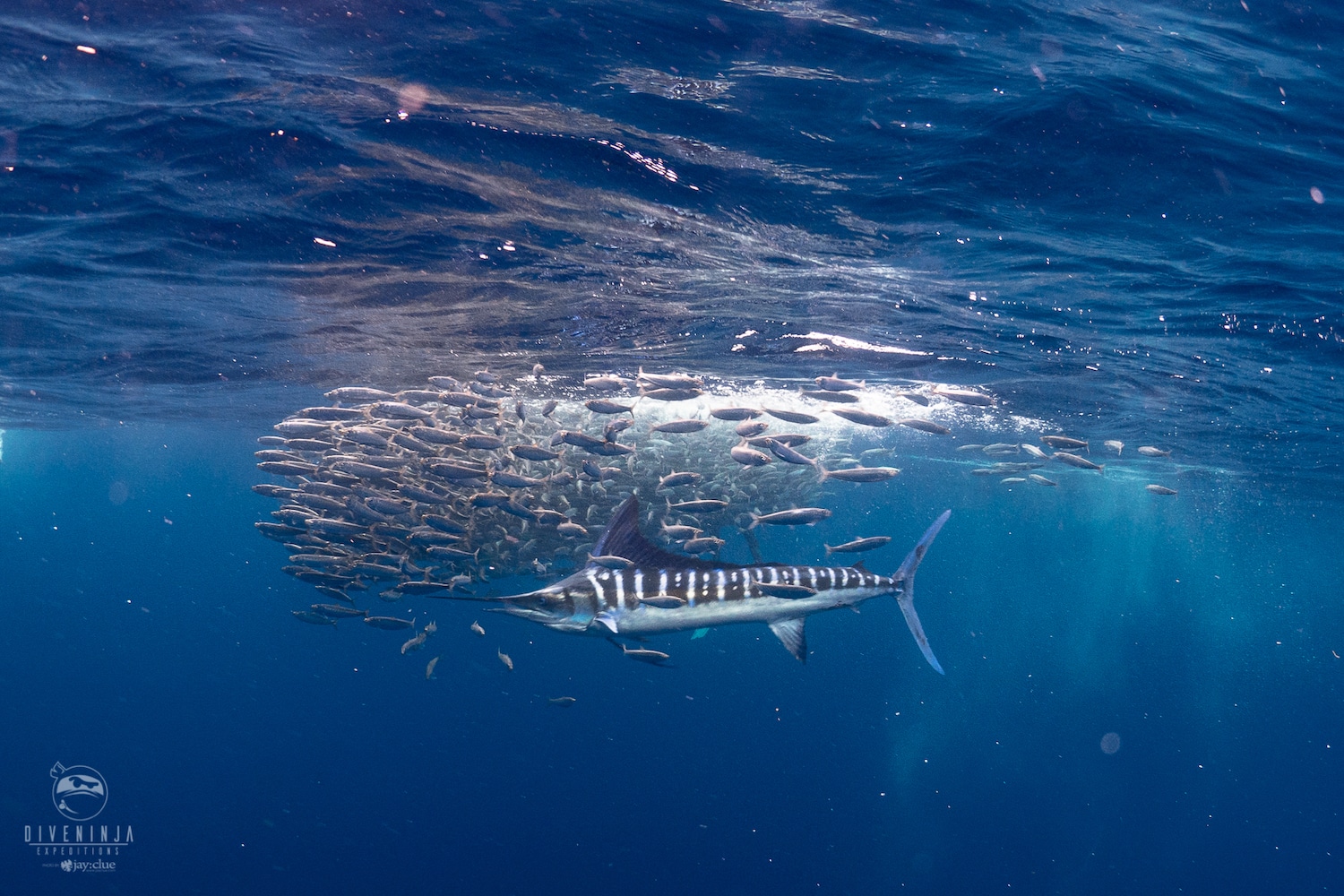
Due to the remoteness of these areas, and the speed at which the bait balls are moving, trips are usually more geared to freediving or snorkeling instead of scuba diving. But don’t sweat it because all the action takes place right at the surface. The marlin use the surface as a barrier to push the bait balls against, making them easier to hunt. So, enjoy not having to stress over airline baggage weight restrictions for this one!
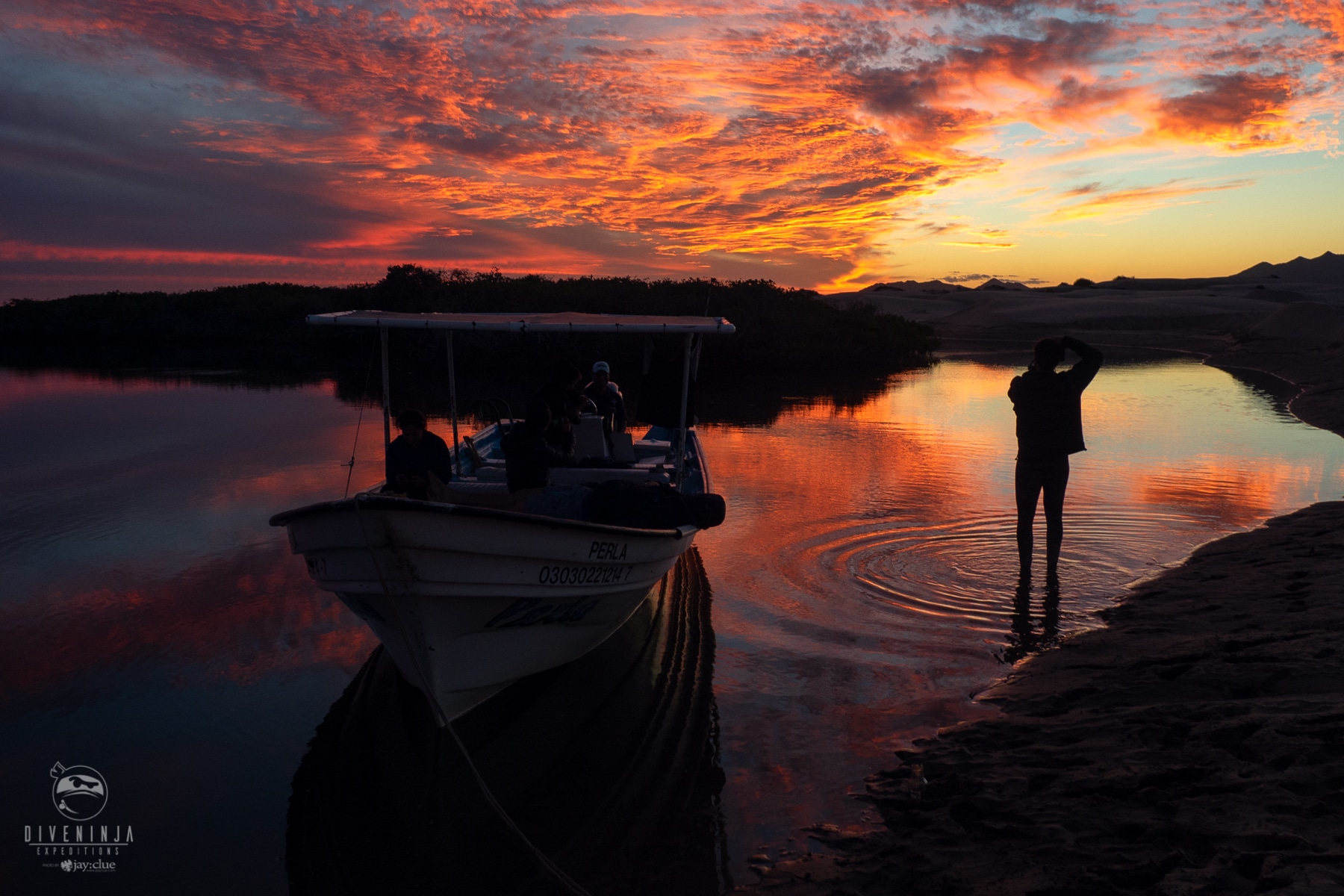
Interested in exploring this adventure yourself? Visit the Dive Ninja Expeditions website. Their 2019 striped marlin season kicks off in the next few weeks and their 2020 Striped Marlin Expedition dates go on sale the beginning of October.
 For more from Jay Clue and Dive Ninja Expeditions, follow:
For more from Jay Clue and Dive Ninja Expeditions, follow:
Instagram: instagram.com/JayClue
Facebook: facebook.com/iamjayclue
Website: www.DiveNinjaExpeditions.com
News
Book Review: Fire on Monroe Bravo by Fred Lockwood

Fire on Monroe Bravo is the latest book in the Jack Collier series by Fred Lockwood. Our story begins with our lead characters, Jack and Sandro, owners of Marine Salvage & Investigation Company, arriving on the Monroe Bravo Oil & Gas Platform in the North Sea. Having secured a contract for their vessel the MV Stavanger to act as support ship to the platform for TransGlobal Oil, our protagonists are on a celebratory visit.
However almost as soon as they arrive a series of explosions rock the platform, causing huge damage, loss of life and the very real danger of a massive human, ecological and financial disaster.

As the danger mounts for both our heroes and the surviving workers, Jack and Sandro will have to escape the inferno, all while trying to save the platform and the men still trapped unable to help themselves.
The disaster sets the scene for the unfolding story lines following the fate of the platform and our main characters, the police investigation into a suspected terrorist act and the actions of TransGlobal Oil as they attempt to navigate the pubic outcry and financial repercussions.
In his eighth book, Fire on Monroe Bravo, Fred Lockwood delivers an explosive thriller, with plenty of above and in-water drama, and our heroes fighting for survival, what more can you ask for?
We thoroughly recommend this read and look forward to the next in the series. For more information about his book series, you can check out the reviews of his previous books here on Scubaverse.
- Title: Fire On Monroe Bravo
- Author: Fred Lockwood
- ISBN: 979-8325324536
Available in a paperback version and for Kindle from Amazon and book stores.
Blogs
Alonissos: The complete diving destination (Part 1)

In June we were incredibly fortunate to be invited to dive in Alonissos, a small Greek Island in the Sporades island chain located in the North Aegean Sea. While I have long been a big fan of the Greek Islands as a great holiday destination, I had not had the opportunity to do any diving on previous visits and Mike and I were extremely excited to see what Alonissos had to offer both above and below the surface!

The Sporades are easily accessible via the airport in Skiathos (the first island in the chain), which is served by Jet2 flights from all major UK airports from May through October. Numerous ferries and charter boats make island hopping from Skiathos Town a breeze. After an hour boat ride, the picturesque port of Patitiri was a wonderful introduction to Alonissos, where we were met by our gracious hosts Kostas of Albedo Travel and Dias of Alonissos Triton Dive Center. Mike and I were delighted to be staying at the Paradise Hotel, aptly named for its stunning views over the sea and great location for walking to the waterfront.

Alonissos is beautifully situated in the National Marine Park of Alonissos and the Northern Sporades, the largest marine protected area in Europe. The surrounding seas offer fabulous marine life, including incredibly rare species such as the Mediterranean monk seal. They boast deep walls covered in gorgonians and sponges, stunning topography with caverns, swimthroughs and pinnacles, and the first accessible ancient shipwreck from 500BC!

In locations where historical sites have been reported, the waters are largely restricted, but with collaboration between government, underwater archeologists and dive centres, incredible underwater museums are being created for a truly unique diving experience. Alonissos is home to the first of these, the Ancient Shipwreck of Peristera Accessible Underwater Archeological Site. The chance to dive into history (along with reports of healthy reef life and amazing underwater topography) meant Mike and I were keen to get in the water.

Our introduction to the diving around Alonissos was at the Agios Georgios Pinnacles, in the channel between Alonissos and Skopelos. This fantastic site was named “The Chimney,’ and proved to have a huge amount to see. We got to a decent depth here (over 25m), and marvelled at a colourful reef wall with a wonderful swim through whose rocky walls were absolutely covered with life. As well as brilliant topography there was no shortage of macro life here. We saw numerous nudibranchs, five different species in total. The second dive at Mourtias reef nearby was a shallower dive along a nice wall with lots of crevices. Several moray eels and grouper called this site home. We enjoyed looking in the crevices for lobster and smaller benthic life, such as cup corals and tunicates.

Our itinerary allowed us two dives a day with afternoons left to explore the island with our hire car and evenings to enjoy the famous Greek hospitality. This proved to be a lovely mix of in-water and land based diversions.

The next days diving to the Gorgonian Gardens and Triton’s Cave was to be even better! These two stunning sites are nothing short of fabulous. The Gorgonian Gardens was a deep wall near to the Agios Georgios islands. The ever-present currents in this deep channel meant that the sea life was amazing … the namesake Gorgonian sea fans dotted the wall at a depth of 30 to 50 meters, getting ever larger the deeper we went. Above 30m was by no means less beautiful, with sponges, corals, scorpionfish, moray eels and some rare and colourful nudibranchs.

The second shallower dive of the day was to Triton’s Cave or the Cavern of Skopelos, on the east side of that island. The spectacular rock formations had wild striations both above and below the water making a truly epic topography. The cavern entrance was at 14m, and big enough for a buddy pair, winding up to 6m and passing two beautiful windows out into the blue. Emerging from the cavern, the light at the shallower depths and the incredible rock formations made for a fantastic gentle swimming safety stop and we all surfaced by the boat with massive grins.

Check out our next blog :Alonissos: The complete diving destination (Part 2)” to hear about our amazing dive on the 2500 year old Peristera Wreck!
Thanks to:
Alonissos Triton Dive Center https://bestdivingingreece.com/
Albedo Travel https://alonissosholidays.com/activities/
Paradise Hotel https://paradise-hotel.gr/
Alonissos Municipality https://alonissos.gr/en/
-

 Blogs2 months ago
Blogs2 months agoDiving With… Nico, Ocean Earth Travels, Indonesia
-

 News1 month ago
News1 month agoMurex Bangka Announce New Oceanfront Cottages & Beachfront Dining
-

 Blogs2 months ago
Blogs2 months agoA new idea in freediving from RAID
-

 Marine Life & Conservation1 month ago
Marine Life & Conservation1 month agoIceland issue millionaire whale hunter a licence to murder 128 vulnerable fin whales
-

 Marine Life & Conservation2 months ago
Marine Life & Conservation2 months agoThe Shark Trust Great Shark Snapshot is back
-

 News3 months ago
News3 months agoCharting New Waters; NovoScuba Goes Global with the Launch of their Revolutionary Dive Training Agency!
-

 Gear News1 month ago
Gear News1 month agoNew Suunto Ocean – a dive computer and GPS sports watch in one for adventures below and above the surface
-

 Marine Life & Conservation Blogs2 months ago
Marine Life & Conservation Blogs2 months agoBook Review: Plankton















